Mars Curiosity Rover
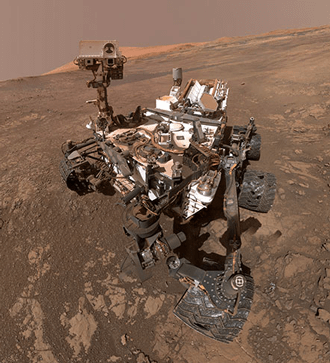
Mars Curiosity rover is about the size of a car, ~10-feet long, 9-feet wide, and 7-feet tall (~3.9m x 2.7m, x 2.2m), and weighs about 900 kg. Curiosity is the 4th Rover that NASA built and successfully sent to explore Mars. When it was launched it was the largest rover NASA ever sent to Mars.
Curiosity launched November 26, 2011 on a United Launch Alliance Atlas V-541 from Cape Canaveral in Florida. It landed on Aeolis Palus inside Gale Crater on Mars on August 6, 2012. The landing site was renamed Bradbury Landing in honor of the science fiction author Ray Bradbury. Curiosity was gently set down by a special landing spacecraft known as a "skycrane" on Mars at Aeolis Palus, inside the crater, below Aeolis Mons, familiarly known as Mount Sharp. You can read about Curiosity's landing on this page.
Mars Curiosity rover is also known as Mars Science Laboratory. It is intended to be the robotic equivalent of a human geologist. Curiosity was sent to Mars during the 2011-2012 opposition. It has been busy exploring the Gale crater, looking for signs of water and organic compounds that may reveal whether or not Mars was habitable or if it ever supported life.
Curiosity Celebrates 10 years on Mars

On August 6, 2022 Curiosity achieved the milestone of spending 10 Earth years on the red planet.
Curiosity is scaling up the side of Mount Sharp testing the surface for geological information as it travels. The rover travels at the rate of ~660 feet (200 m) per day over flat ground. As of August 1, 2022, Curiosity has traveled 17.64 miles or 28.4 km from the Bradbury landing site. It has gained over 2,000 ft. in elevation!
Curiosity is looking for organic compounds that should be present if life can evolve on Mars. It has found such compounds in the samples it collected. It also found that ancient Mars could have supported life, it was habitable. Curiosity's Tunable Laser Spectrometer (TLS) measures methane, carbon dioxide and water vapor in the Martian atmosphere. This instrument indicates that the level of methane near the surface is variable, suggesting some process occurs on Mars that has not yet been fully explained. Methane can be produced by living organisms or by chemical reactions between rock and water, so understanding the process is important.
It hasn't been all smooth sailing for Curiosity either. The rover's wheels showed lots of wear earlier than expected. Curiosity has six wheels that are about 20 inches (50 cm) in diameter and 16 inches (40 cm) wide. The aluminum wheels covered by a skin that is about half as thick as a U.S. dime, although there are thicker treads. Each wheel has 19 grousers that are zigzag-shaped treads that extend about a quarter inch out from the skin of each wheel. The grousers bear much of the rover's weight and provide traction to allow it to travel over uneven terrain. JPL developed software called, traction control, that adjusts the speed of Curiosity's wheels depending on the rocks it's climbing. The wheel problems brought about a change to the design of Perseverance rover's wheel to prevent the type of wheel wear that Curiosity has experienced. The path the rover takes on Mars is carefully selected to avoid further damage.
Problems that developed with Curiosity's drill forced engineers at NASA to find a solution. The drill was designed to use two finger-like stabilizers to steady itself against rock; a bad motor prevented the drill bit from moving past the stabilizers. Leaving the drill in an extended position, engineers developed a method that is more freehand. Curiosity now uses its entire arm to push the drill forward, using its force sensor to preventing the drill bit from drifting sideways. The successful plan they developed has given Curiosity a new method for drilling into rocks and shown that problems that arise while exploring Mars can be solved from Earth.
Congratulations to the JPL and NASA teams and of course our distant geologist, Curiosity Rover, for 10 successful years of Mars exploration!
Best of Curiosity
One of my favorite Curiosity highlights from NASA's Mars Curiosity Image Gallery is the meteorite that the rover found. Curiosity took this image from the Mast Camera (Mastcam) of a dark, smooth-surfaced rock on Octber 30, 2016.

Curiosity used its Chemistry and Camera (ChemCam) and examined with laser pulses that showed it to be an iron-nickel meteorite. The shiny points that are visible on the meteorite resulted from that laser zapping by Curiosity's instrument. It is informally named "Egg Rock" after a site in Maine. The meteorite is about the size of a golf ball. Iron-nickel meteorites are found on Earth, and previous examples have been found on Mars, but Egg Rock is the first Martian meteorite to be examined with a laser-firing spectrometer.
The image here was formatted for Astra's Stargate and has been cropped from NASA's original. If you are interested in finding the original NASA image, its name is pia21134.jpg
Curiosity's Mission on Mars
Curiosity's primary mission, is to explore the Gale crater landing site. Through imaging and spectroscopy, it will gather data, taking measurements for selected Martian soils, rocks, and the atmosphere. The science team data will use the data to assess the Mars' habitability and its environmental history. The mission's primary objectives are to assess the biological potential of the landing site, characterize the geology of the explored region, investigate planetary processes that influence habitability, and characterize the broad spectrum of surface radiation. The mission was planned to last one Mars year (687 days) on the surface of Mars, but on August 5, 2022, Curiosity can celebrate 10 years on the martian surface.
Curiosity rover mission objectives:
The Curiosity rover is seeking evidence of organics, the building blocks of life. It is seeking out places with water and the chemistry that can provide habitable conditions for life. It is working on NASA's main science goals of its Mars Exploration Program:
- Determine whether life ever arose on Mars.
- Characterize the climate of Mars.
- Characterize the geology of Mars.
- Prepare for human exploration.
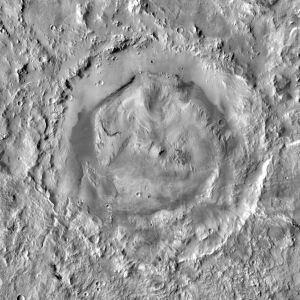
Curiosity landed in Gale Crater, a large impact crater located at 5.4°S 137.8°E. It is 96 miles or 154 km in diameter. It is thought to be about 3.5 billion years old.
The image of Gale Crater was taken by Mars Odyssey using its THEMIS instrument. It was made using over 200 images that were stitched together. This image can resolve details that are 60 feet (18 m) in size. At this scale, the Curiosity would not be seen although this image was created before the rover arrived.
Gale crater is located at Mars 4.5 deg. S lat. 137.4 deg. E. longitude on Isidus Planitia that is located near the well-known martian feature of Syrtis Major. Jezero crater is 45km in size, so it will not be easily seen on the small image that shows the crater in a small section of the USGS map of Mars.
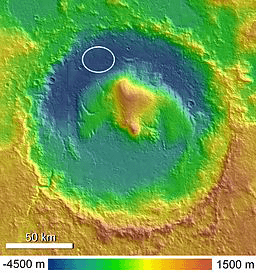
where Curiosity is exploring
CC3.0 license
Curiosity's Mars mission is devoted to the study of rock and regolith - following the water - it is easy to think of the rover as a geologist, but that is not the only purpose it will fulfill on Mars. Curiosity is studying natural materials such as the rock and sediments on Mars to determine whether or not it ccould offer humans some protection from Mars' ever-present space radiation.
In the center of Gale crater is a large layered mountain left created by the impact that is informally named "Mount Sharp" in honor for geologist Robert P. Sharp. Sharp was an expert on Earth and Mars geology and the department chair of the Division of Geological Sciences at the California Institute of Technology. Mount Sharp rises higher above the crater floor than Mount Rainier rises above Seattle!
Curiosity landed at the foot of Mount Sharp within Gale crater. The area where Curiosity landed has an alluvial fan that may have been formed by water-carried sediments. The layers at the base of the mountain contain clays and sulfates, that may have formed in water. Curiosity 's science payload can also identify other ingredients of life, such as the carbon-based organic compounds.
Curiosity Instruments

Curiosity has three different cameras or imagining systems:
Mastcam is a camera system that is mounted on the rover’s mast. The camera takes color images and color video footage of the Martian terrain. The images can be stitched together to create panoramas of the landscape.
MastCam has two cameras, the Medium Angle Camera (MAC) with a 15-degree field of view, and the Narrow Angle Camera (NAC) with a 5.1-degree field of view.
Mars Descent Imager (MARDI) was used to take a color video of the terrain below the rover as it descended to its landing site. This video helped mission planners choose the best path for Curiosity to follow when it began exploring Gale Crater.
Mars Hand Lens Imager (MAHLI) was designed to work like a magnifying hand lens that geologists usually carry. MAHLI's close-up images are used to detect the minerals and textures in rock surfaces.
Curiosity has four different spectrometers onboard:
Alpha Particle X-Ray Spectrometer (APXS) uses two kinds of radiation to measure the amounts and types of chemical elements that are present. Mounted on the robotic arm, measurements are taken with the instrument directly contacting the target or hovering 2 cm or less away. X-rays emitted from the sample take 15 minutes to 3 hours to measure.
Chemistry and Camera tool (ChemCam) is an experiment that will produce a small amount of oxygen (O2) from the carbon dioxide (CO) in Mars' atmosphere. ChemCam uses a laser, a camera and a spectrograph to identify the chemical and mineral composition of rocks and soils.
Chemical and Mineralogy instrument (CheMin) performs chemical analysis of powdered rock samples to identify the types and amounts of different minerals that are present.
Sample Analysis at Mars tool (SAM) has three different instruments to search for and measure organic chemicals and light elements that are important ingredients that may be associated with life. It is about the size of a microwave oven and weighs about 40 kg on Earth.
SAM includes a gas chromatograph to separates gases, a mass spectrometer to identify elements, a tunable laser spectrometer to detect water. SAM also has the Sample Manipulation System (SMS): a wheel holding 74 small cups for samples. Nine cups contain calibration samples and nine are filled with chemical solvents. SAM has 59 quartz cups that are small ovens to heat powdered samples to extract gases. These ovens heat rock samples to about 1,000 deg. Celsius or about 1,800 deg. Fahrenheit, to extract gases for the SAM instruments to analyze.
Curiosity has two radiation detectors:
The Radiation Assessment Detector (RAD) measures the type and amount of radiation that reaches the Martian surface from the sun and other space sources. RAD is helping to prepare for the future human exploration of Mars.
The Dynamic Albedo of Neutrons tool (DAN) looks for changes in the way neutrons are released from Martian soil in order to detect liquid or frozen water underground.
Other sensors Curiosity carries include:
Rover Environmental Monitoring Station (REMS) contains the weather instruments that provide daily and seasonal reports on meteorological conditions around the rover.
Mars Science Laboratory Entry Descent and Landing Instrument (MEDLI). MEDLI was used during the rover's descent to measure the heating and atmospheric pressure changes that occurred to help determine the effects on different parts of the spacecraft as it landed on the surface.
- Learn more at NASA's Curiosity Rover Page
Curiosity Lands on Mars
Before the landing of Curiosity, NASA created this diagram to explain how the rover would reach the surface of Mars. Instead of bouncing around the surface with massive balloons, because of its weight, Curiosity was carried to the surface by a spacecraft known as a skycrane. But there was still uncertainty that the landing would be successful.
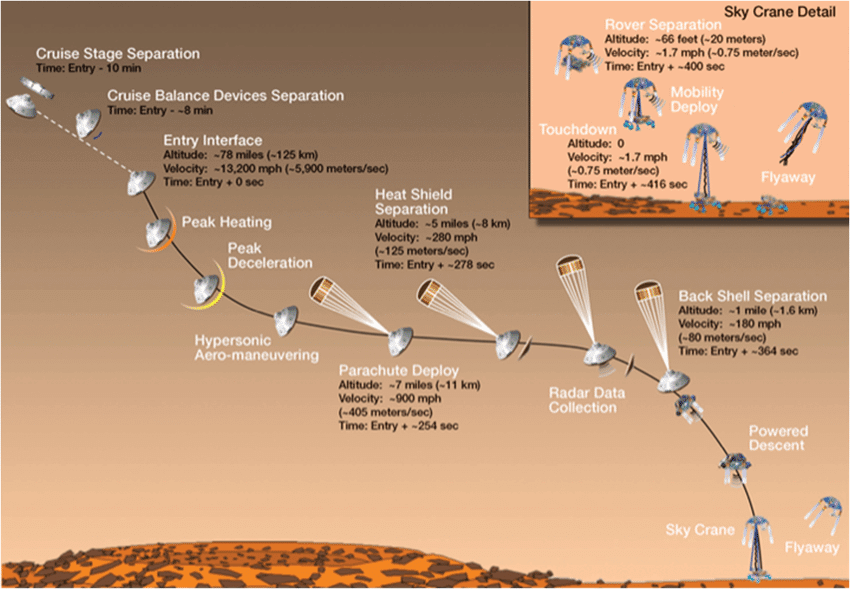
NASA's description of the diagram: "In the depicted scene, the spacecraft's descent stage, while controlling its own rate of descent with four of its eight throttle-controllable rocket engines, has begun lowering Curiosity on a bridle. The rover is connected to the descent stage by three nylon tethers and by an umbilical providing a power and communication connection. The bridle will extend to full length, about 25 feet (7.5 meters), as the descent stage continues descending. Seconds later, when touchdown is detected, the bridle is cut at the rover end, and the descent stage flies off to stay clear of the landing site. "
The Sky Crane sets the rover on its wheels. Its new entry, descent and landing (EDL) procedure is a guided entry for a more precise landing. The Mars Science Laboratory could land within a 12-mile (20-km) area. has a large parachute that slows down the descent of the rover.

After arriving at Mars, NASA checks out Curiosity to be sure its mission can be successfully carried out. All of the various instruments are tested, before the rover can roll off and begin exploring Gale Crater.
On August 5, 2012, Curiosity landed on Mars! Here's the first image Mars Science Laboratory rover returned. The shadow of the rover is visible in the martian sun.
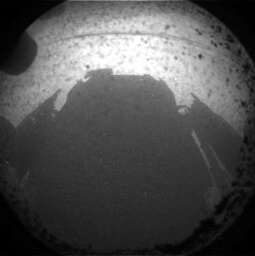
Curiosity's first images was taken through a "fisheye" wide-angle lens. The dust cover is still on the camera. Later pictures are taken from the high resolution cameras on the rover's mast that can be taken in full color. Before curiosity, NASA had no experience with the skycrane landing. For Perseverance rover launched in 2020, they installed cameras that could take an actual image of the rover from the skycrane. Here is NASA's infographic of Curiosity's landing sequence.
Navigate Astra's Guide to Mars Exploration:
3 Faces of Mars Home | Mars Orbital Explorers | Mars 2020 | Mars Rovers | Curiosity Rover | Perseverance Rover
This web page is ©2022 D. E. Jenkins all rights reserved. Please use the contact page to get permission to use this content or to send comments or corrections. Images on this page are available from NASA.

